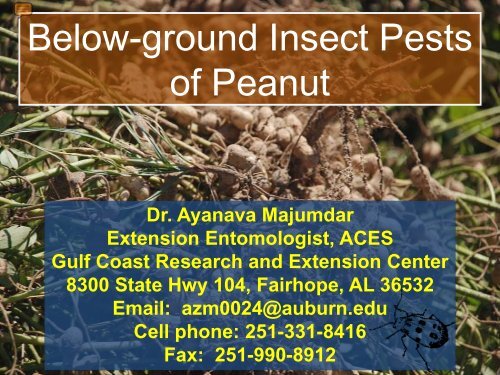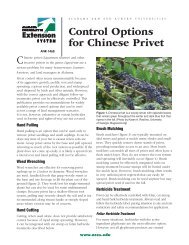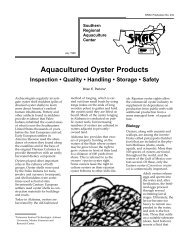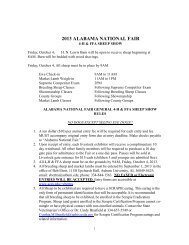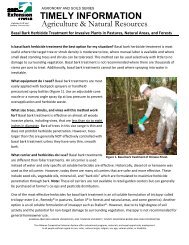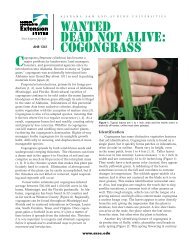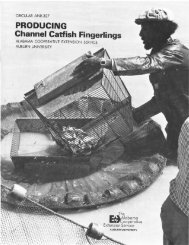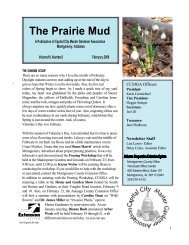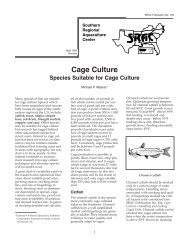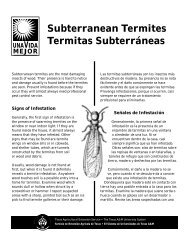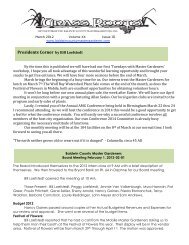Below-ground Insect Pests of Peanuts
Below-ground Insect Pests of Peanuts
Below-ground Insect Pests of Peanuts
Create successful ePaper yourself
Turn your PDF publications into a flip-book with our unique Google optimized e-Paper software.
<strong>Below</strong>-<strong>ground</strong> <strong>Insect</strong> <strong>Pests</strong><br />
<strong>of</strong> Peanut<br />
Dr. Ayanava Majumdar<br />
Extension Entomologist, ACES<br />
Gulf Coast Research and Extension Center<br />
8300 State Hwy 104, Fairhope, AL 36532<br />
Email: azm0024@auburn.edu<br />
Cell phone: 251-331-8416<br />
Fax: 251-990-8912
Hemiptera: Cydnidae<br />
Burrower bugs<br />
• Six species in peanuts, Pangaeus bilineatus<br />
most prevalent, sporadic late‐season pest<br />
• Host range: peanut, cotton, strawberry,<br />
spinach, wild plants<br />
• Identification: small insects, note wing<br />
structure & spines on legs<br />
• Overwintering stage: adult, under rocks,<br />
crop stubble, volunteer plants<br />
• Behavioral clues:<br />
– eggs laid singly near roots & pods<br />
– adults/nymphs walk along soil cracks<br />
– soil moisture affect movement<br />
– adults attracted to white light
Damage by burrower bugs<br />
• Damaging stages: adult, nymph<br />
• Problem in conservation tillage<br />
• Mouthparts are inserted into<br />
maturing kernel<br />
• Light yellow/brown feeding<br />
spots “pitting”<br />
• Loss in kernel weight and no. <strong>of</strong><br />
sound kernel
Scouting techniques (burrower bugs)<br />
• Spade sampling/soil corer >> sieving (5‐ to 12 mesh) (July<br />
–Aug.)<br />
• ET = 2 bugs per three feet row<br />
• Underutilized techniques: light trap, pitfall trap<br />
• Direct examination <strong>of</strong> pods (after the full seed, R6, stage)<br />
Pitfall trap with<br />
metal guide & cover<br />
Spade sampling
Coleoptera: Curculionidae<br />
Whitefringed beetles<br />
• Occurrence: native <strong>of</strong> S. Am., Naupactus<br />
species complex<br />
• Host range: 350 host plants – peanut,<br />
cotton, cowpea, alfalfa, okra, grasses<br />
• Identification: looks like a boll weevil but<br />
no snout, adult has white stripes on<br />
sides, larva plump with reduced head<br />
• Overwintering stage: larvae (10‐12 in.<br />
deep in soil), eggs<br />
• Behavioral clues:<br />
• Emergence starts in April‐July<br />
• 1 to 2 yr life cycle<br />
• Females have keen host‐finding<br />
ability, can’t fly…
Damage by whitefringed beetles<br />
• Damaging stages: adult, nymph (chewing mps)<br />
• Larvae –irregular holes in tap root, fatal to plants<br />
• Root injury resembles wireworm, rootworm, white<br />
grub feeding<br />
• Stand losses early & mid‐season<br />
• Can reach high pop. density – 186 per cu m<br />
• Notched leaves??
Scouting techniques<br />
(whitefringed beetles)<br />
• Soil cores/spade sampling prior to planting season<br />
• Visual & beat cloth sampling for adult beetles (females)<br />
• Underutilized techniques:<br />
– Sweep net for adult beetles<br />
– Floatation technique for small larvae
Coleoptera: Chrysomelidae<br />
Southern corn rootworm<br />
• Occurrence: throughout U.S., immature<br />
form <strong>of</strong> spotted cucumber beetle<br />
(Diabrotica u. howardi)<br />
• Host range: 200 host plants, major pest <strong>of</strong><br />
corn, sweet potato, peanut<br />
• Identification: wing pattern on adult<br />
beetles, larvae have 3 pr <strong>of</strong> legs<br />
• Overwintering stage: adult beetles (mostly<br />
female beetles)<br />
• Behavioral clues:<br />
• short overwintering period<br />
• high fecundity, eggs laid in soil at plant<br />
bases<br />
• adaptable to crop rotations??
Damage by southern corn rootworm<br />
• Damaging stage: larvae<br />
• Stand loss (early season damage)<br />
• Larvae make a hole on one side <strong>of</strong><br />
the pod and feed on kernel<br />
• High OM, heavy soil >> high risk<br />
• Adult beetles feed on leaves, but<br />
not a problem.<br />
• Electronic risk index by NCSU >><br />
high risk (score 70+) in wet years,<br />
low risk (score
Scouting techniques<br />
(southern corn rootworm)<br />
• Larval infestation –scout close to pegging stage<br />
• Spade sampling with a tray (larvae drop <strong>of</strong>f quickly)<br />
• Sweep net sampling for adults is reliable (10 sweeps/10<br />
paces X 5 loc./A)…midmorning<br />
• Check pods for circular holes at one end<br />
• ET: fresh damage evident OR larvae present in 1/3 rd sites
Lepidoptera: Pyralidae<br />
Lesser cornstalk borer<br />
• Occurrence: one <strong>of</strong> the major insect<br />
pests <strong>of</strong> peanut, sporadic<br />
• Host range: wide, hot‐spots in peanut<br />
• Identification: larvae are blue‐green<br />
with purple bands. Moths are grayish,<br />
wings folded at rest, bushy abdomen<br />
(females)<br />
• Overwintering stage: larvae/pupae<br />
• Behavioral clues:<br />
• able to survive dry soils (escapes<br />
predation)<br />
• attracted to CO 2 and heat from plant<br />
roots<br />
• larvae make sand tubes
Damage by lesser cornstalk borer<br />
• Damaging stage: larvae feed just<br />
below soil surface<br />
• Larvae makes sand tubes on pods<br />
and stem<br />
• High risk to peanut in hot dry years,<br />
sandy soil<br />
• Spreads southern stem rot between<br />
plants
Scouting techniques<br />
(lesser cornstalk borer)<br />
• Pod sampling – reliable indicator <strong>of</strong> infestation<br />
• Scouting maps available from AWIS website –based on<br />
the estimation <strong>of</strong> borer days on a scale <strong>of</strong> 0 to 5<br />
• ET – control when fresh damage is present OR when<br />
insect is recovered from 1/3 rd sample sites
Coleoptera: Elateridae<br />
Wireworms<br />
• Occurrence: many species (Conoderus),<br />
sporadic/key pest<br />
• Host range: several plants (extended life<br />
cycle allows use <strong>of</strong> resources)<br />
• Identification: larvae with cylindrical<br />
body, wriggle furiously when touched,<br />
adults are click beetles<br />
• Overwintering stage: larva, beetle<br />
• Behavioral clues:<br />
• very attracted to CO 2 and heat from<br />
plant roots<br />
• optimum SM for movement = 8 to 16%<br />
• high mobility & chemical repellency
Damage by wireworms<br />
• Damaging stage: larvae feed at<br />
various depths<br />
• Early season damage to peanut >><br />
loss <strong>of</strong> plant stand<br />
• Doesn’t like saturated SM, causes<br />
migration & spread<br />
• Major problem following sod<br />
• Larvae attack pod: make a large<br />
entry hole on a side<br />
• Large larvae feeds with part <strong>of</strong><br />
body outside
Scouting techniques (wireworms)<br />
• Study field history –crop rotation, previous infestations<br />
• Germinating seed baits in soil –a reliable “relative<br />
sampling” technique<br />
• Seed baits could be put previous season or before<br />
planting peanut (about 12 in a 40 A field)<br />
• Accuracy <strong>of</strong> seed baits improves with number <strong>of</strong> baits<br />
and experience <strong>of</strong> the field personnel<br />
• ET = 1 wireworm per bait station OR 30% pod damage
Agrotis ipsilon<br />
Agrotis subterranea<br />
Lepidoptera: Noctuidae<br />
Cutworms<br />
• Occurrence: throughout AL, black cutworm<br />
(Agrotis ipsilon), granulate cutworm (A.<br />
subterranea) common<br />
• Host range: over 60 crops and turf, major<br />
pest <strong>of</strong> peanut<br />
• Identification: moths have dark forewings &<br />
white hindwings, greasy plump caterpillars,<br />
larvae curl when touched<br />
• Overwintering stage: larva<br />
• Damage:<br />
• cut seedlings at night, may climb plants<br />
• granulate CW bore into the middle <strong>of</strong><br />
peanut pod (large hole)
Scouting techniques (cutworms)<br />
• Often detected when scouting for other insects<br />
• Look directly under the base <strong>of</strong> cut plants<br />
• Risk higher in dry conditions, well drained soils<br />
• Pheromone trapping (bucket/wing traps for moths)<br />
Pheromone lure & trap suppliers:<br />
• Phero Tech Inc. http://www.pherotech.com<br />
• Scentry Biologicals Inc. http://www.scentry.com<br />
• Great Lakes IPM Inc., http://www.greatlakesipm.com<br />
• Gemplers Inc. http://www.gemplers.com
Other sporadic insect pests<br />
White grubs<br />
(Phyllophaga spp.)<br />
May/June Beetles<br />
1-4 year life cycle<br />
Problem after sod<br />
Bahiagrass borer<br />
(Derobrachus brevicollis)<br />
Large head <strong>of</strong> larva<br />
Problem after bahiagrass
Scouting recommendations<br />
• Draw soil samples in Winter or Spring.<br />
• Reduce tendency to overestimate –increase sampling sites!<br />
• Use a variety <strong>of</strong> sampling methods – pheromone traps and<br />
germinating seed bait stations are cost effective!
Scouting recommendations (contd.)<br />
• Economic thresholds:<br />
Soil‐dwelling: burrower bug = 2 bugs per 3 foot row<br />
Soil‐air interface:<br />
Cutworms, armyworms = 4 or more larvae per foot<br />
LCSB, SCRW = fresh damage or insect at 30% sites<br />
Wireworms = 1 per bait station or 30 % pod damage
Burrower bugs<br />
Chlorpyrifos<br />
(banded over<br />
row)<br />
<strong>Insect</strong>icides for soil insects<br />
LCSB<br />
Chlorpyrifos<br />
(banded over<br />
row and pegging<br />
zone)<br />
SCRW<br />
Chlorpyrifos<br />
(banded over<br />
row and pegging<br />
zone)<br />
Wireworms<br />
Chlorpyrifos<br />
(preplant<br />
broadcast spray<br />
on soil +<br />
incorporate OR<br />
banded)<br />
Cutworms<br />
Indoxacarb<br />
Cyfluthrin<br />
Gamma‐cyhalo.<br />
Lamdba‐cyhalo.<br />
Methomyl<br />
Zeta‐cypermeth.<br />
• What affects insecticide efficacy? Timing & placement, soil<br />
temp. & moisture, microorganisms<br />
• Additional insecticides need to be registered (suggestions?).
Take home message for today…


